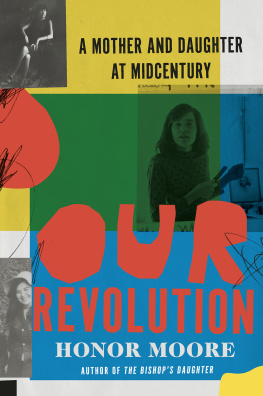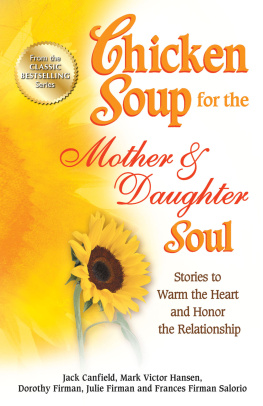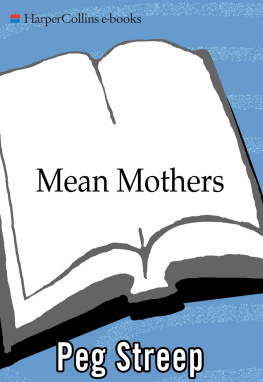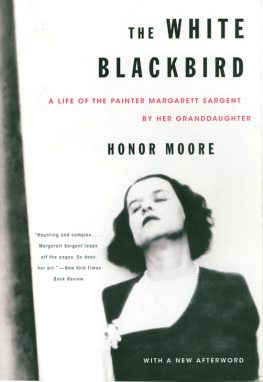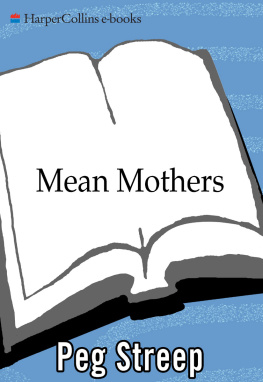Contents
Guide

ALSO BY HONOR MOORE
The Bishops Daughter: A Memoir
The White Blackbird: A Life of the Painter
Margarett Sargent by Her Granddaughter
POETRY
Red Shoes
Darling
Memoir
Mourning Pictures (play in verse)
EDITOR
Poems from the Womens Movement
Amy Lowell: Selected Poems
The New Womens Theatre
The Stray Dog Cabaret:
A Book of Russian Poems (with Catherine Ciepiela)
The New Womens Theatre: Ten Plays by Contemporary Women
TRANSLATOR
Revenge by Taslima Nasrin (with the author)

OUR REVOLUTION
A MOTHER AND DAUGHTER AT MIDCENTURY
HONOR MOORE

Copyright 2020 by Honor Moore
All rights reserved
First Edition
For information about permission to reproduce selections from this book, write to Permissions, W. W. Norton & Company, Inc., 500 Fifth Avenue, New York, NY 10110
For information about special discounts for bulk purchases, please contact W. W. Norton Special Sales at specialsales@wwnorton.com or 800-233-4830
Jacket design: Robin Bilardello
Jacket photographs: (top) William Albert Allard;
(center) Liberty Redmond; (bottom) Paul Moore
Book design by Chris Welch
Production manager: Julia Druskin
The Library of Congress has cataloged the printed edition as follows:
Names: Moore, Honor, 1945 author.
Title: Our revolution : a mother and daughter at midcentury / Honor Moore.
Description: First edition. | New York : W. W. Norton & Company, [2020] | Includes bibliographical references.
Identifiers: LCCN 2019045940 | ISBN 9780393080056 (hardcover) | ISBN 9780393651805 (epub)
Subjects: LCSH: Moore, Honor, 1945 | Moore, Honor, 1945 Family. | Moore, Jenny, 1923 | Mothers and daughtersUnited StatesBiography. | Women authors, AmericanBiography.
Classification: LCC PS3563.O617 Z75 2010 | DDC 818/.5403 [B]dc23
LC record available at https://lccn.loc.gov/2019045940
W. W. Norton & Company, Inc., 500 Fifth Avenue, New York, N.Y. 10110
www.wwnorton.com
W. W. Norton & Company Ltd., 15 Carlisle Street, London W1D 3BS
For her grandchildren and great-grandchildren, all born
after she left the planet:
Eli, Avery, Quincy, Finnian, Carrick, Amias,
Rowan, Faye, Violet, Leo, Indiana, Jamie,
Eamon, Maeve, Nick, Thomas, Ruby, Arlo,
Theo, August, Addie, Cosmo, Susie, Pierce,
Jenny, Antonio, Alicia, Izola, Amo, Koa,
and those still to come.
For Sarah Chalfant, believer and guide.
CONTENTS
Authors Note
My mothers writings and what she says are rendered in italics .
Source notes follow the text.
OUR REVOLUTION

IT WAS A CATASTROPHE, HER SUDDEN DEATH, A BREAK IN THAT STREAM of birthday celebrations and Christmases, disruption of the ever-renewing sequence of photographslittle girls in bright-colored coats, little boys in red overalls, photo-ready smiles, with her, with our father. She would get home first with us, not standing with him at the church door as people left, as he shook their hands or embraced them. Or maybe she hadnt gone to the morning service, had gone only to midnight mass the night before, waited till we were all in bed then filled the stockings, eaten Santas cookies leaving crumbs, and later, as they sat with friends drinking and laughing, had asked someone please to drink half Santas glass of milk. The stockings were nylon, the ones with runs she saved for the purpose. She wrapped every present in bright tissue and put it in a stocking so that all she had to do was replace the empties hung from the mantelpiece with the full ones shed been stuffing for weeks. Eventually there were nine of us, but her diligence did not waver. Sometime after I reached my teens, she began to use pantyhose.
Is that her I see now, walking across the meadow outside my window, the ground-length white coat, white hair, chin raised, winter sun at her face? And then her face turns to me, dark blue eyes, the look that contains all I do not know. Its the Christmas I am sixty-seven, and I am leafing through photographs, her letters, the unfinished writing she left me in her will. Or: it is a Christmas in the early 1950s, and I am coming down the stairs, maybe six years old, and she is standing there, dancing, singing, I saw Mommy kissing Santa Claus, underneath the mistletoe last night.
If she were alive now, she would be almost ninety.
The low December sun has settled on the winter yellow of the meadow in the New Hampshire studio where I am writing. The pines are green dulled to black, and spattered close to me at the foot of a stone wall is what remains of the snow; through the pines, another building.
In a photograph of her taken at a party some years before the accident, she wears a sleeveless white brocade sheath, quite short since its 1971, is standing in the corner of the room at a party, her smile ablaze. Yes, her death was a catastrophe, each of her children thrown into individual sorrow, into our lives, now without the attentiveness of her companionship. She bought a blue suede dress to wear when she visited President Kennedy. When he was killed she passed the dress to me, and it was stolen from the college costume shop where I had taken it to be altered. Im sorry, they said, as if what I had lost was only a dress. There is a woman in white coming toward me along the narrow road. She is taller than I am and she has black hair. I cant make out her face. These past days that word catastrophe , and in my imagination a blank of forgetfulness. The woman in white walking toward me on the winter road, the woman dancing at the foot of the stairs Christmas morning, the woman in white glistening in the corner of a room at a party, her black hair tangling on the white pillow of a deathbed.
I have some of the photographs I took of the Christmas after she died: Patience, my youngest sister then eleven, in the Lanz flannel nightgown given to her by our mother the Christmas before; Marian, born sixth and seventeen, also in a Lanz nightgown, an expectant look on her face, as if our mother had not died, as if she were in the room with us, about to say one of those things shed say that would send all of us off into gales of laughter. Peel me a grape, when someone asked her to do something he could perfectly well do himself. For a few years shed been ordering seven nightgowns, keeping one, sending one to each of her six daughters. She loved inventing traditionsidentical Easter dresses when we were just three girls, identical yellow terry cloth bathrobes when we were six children, for all of us, even herself and our father: Pop arranged us on the porch one summer afternoonMom with Marian, then a baby, on her lapset the camera on a chair, ran back around to join us before the minute was up.
It is January 1970, and shes been to Boston to visit her mother, bedridden and now living in an apartment high above the Public Garden. Not as difficult as usual, she was thinking, her mother now almost eighty, not quite as dangerous now that drugs controlled the mania that once had her calling everyone on the Eastern Seaboard, giving lobster dinners for thirty in the Tremont Street high-rise two-bedroom, the depression that turned her silent and monosyllabic for weeks at a time. Just two hours with her mother, lunch with her mothers lawyer, a visit with her second daughter who is in her second year at Radcliffe.

